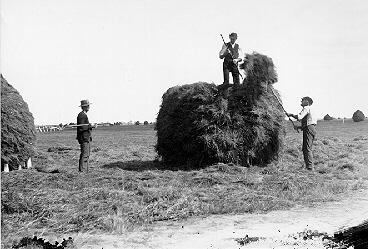By John M. Holman, Hampton History Volunteer

on the Hampton marshes.
{l. to r.: Gilman Mace, George Dearborn, Herbert Blake}
Back in the early days of Hampton, the marsh hay was cut with scythes when the tide was low in the summer and fall. Then it was stacked on “staddles” (wooden posts driven into the marsh usually cut from oak or cedar) which can be seen in the post card photo. After sufficient time had gone by to allow proper drying and when the marshes had frozen up, the farmers would drive onto the frozen marsh with sleds or big hay wagons whose wheels had especially wide, thin wooden treads to prevent the wagon from sinking into the marsh. “Bog Shoes” which were usually of wood with iron hardware were worn over the hooves of the horses to prevent them from sinking into the salt marsh while pulling the wagons or sleds.
When the farmers got thirsty from the strenuous work, they would call out “Hey-Boy!” and a boy would come a-running with a jug of “Switchel Water”. This was a thirst quenching drink made up at home before going to work in the fields or haying the marsh. The ingredients varied from farmer to farmer. A comparative drink today sold commercially is “Gatorade”. Other names of this type drink were called “Sweet Water” or “Swigem” depending on the state lived in.
Hay “staddles”, “bog shoes”, scythes, marsh hay rakes and loafer rakes are on display at the Farm Museum at 40 Park Avenue. Check local newspapers for times of opening of the Tuck Memorial Museum. Special tours can be arranged by appointment.
and Haying the Marshes in Hampton
Return to Table of Contents]